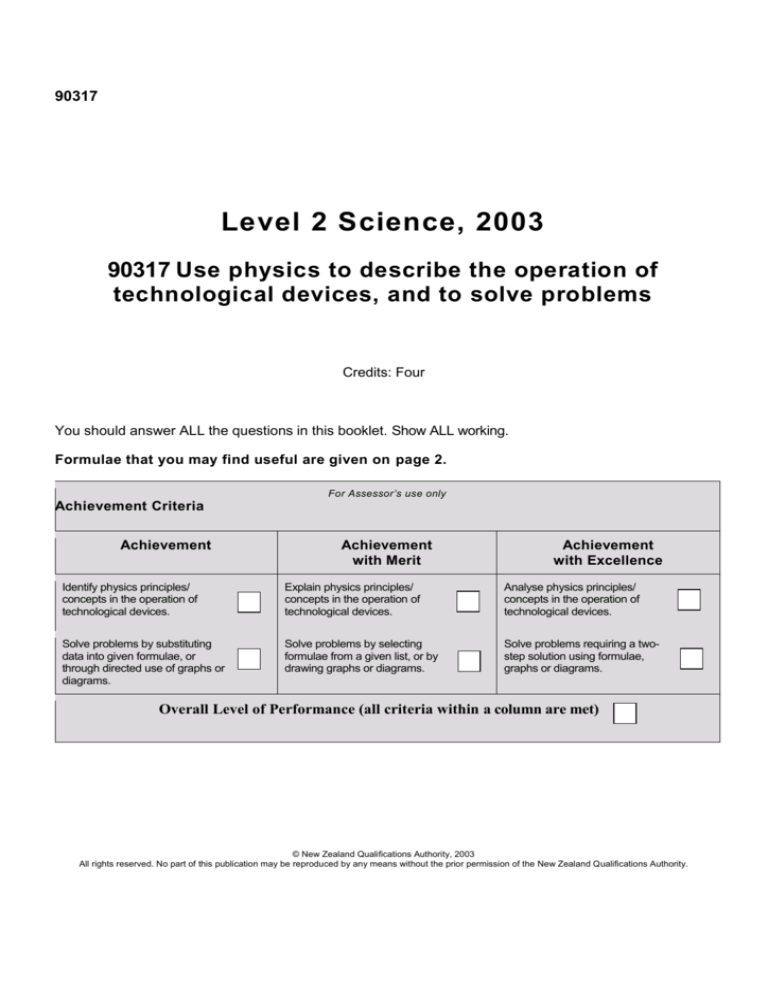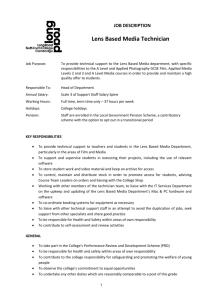
90317
Level 2 Science, 2003
90317 Use physics to describe the operation of
technological devices, and to solve problems
Credits: Four
You should answer ALL the questions in this booklet. Show ALL working.
Formulae that you may find useful are given on page 2.
For Assessor’s use only
Achievement Criteria
Achievement
Achievement
with Merit
Achievement
with Excellence
Identify physics principles/
concepts in the operation of
technological devices.
Explain physics principles/
concepts in the operation of
technological devices.
Analyse physics principles/
concepts in the operation of
technological devices.
Solve problems by substituting
data into given formulae, or
through directed use of graphs or
diagrams.
Solve problems by selecting
formulae from a given list, or by
drawing graphs or diagrams.
Solve problems requiring a twostep solution using formulae,
graphs or diagrams.
Overall Level of Performance (all criteria within a column are met)
© New Zealand Qualifications Authority, 2003
All rights reserved. No part of this publication may be reproduced by any means without the prior permission of the New Zealand Qualifications Authority.
2
You are advised to spend 45 minutes answering the questions in this booklet
Formulae that may be useful:
1 +
d1
W = Fd
1
d2
=
1
f
p = mv
SiSo = f2
M=
H1
=
Ho
T = Fd^
P=
E
So
f
=
f
=
So
E k = ½ mv2
t
Ep = mgΔh
Ep =½kx2
F = kx
work output
Efficiency ==___________________ X100
work input
Part A: The Camera
QUESTION ONE
The lens of a camera focuses light onto a film.
(a)
What shape of lens is used in a camera so that an image is formed on t he film?
(b)
Describe the nature of the image formed on the film by the camera lens.
d1
do
3
(c)
The lens in the camera shown in Fig. 1 on page 2 has a focal
length of 55 mm. The amount of light entering a lens is
controlled by the aperture. In Fig. 2, the lens is set on an ‘fstop’ (or ‘focal ratio’) equal to 11. The focal ratio of a lens is
defined as
focal ratio = ½
where f = focal length
a = diameter of the aperture
Fig. 2
Calculate the diameter of the aperture at this setting.
(d)
In Fig. 3, the lens is focused on an object a very long distance away, normally referred to as
‘infinity’, •.
Fig. 3
Draw an accurate diagram in the box below to show how two light rays from ‘infinity’ pass through
the lens and onto the film. Label the focal length.
Position of lens
4
(e)
In Fig. 4, the lens is focused on an object only 0.45 m
away. You will notice that the lens is now further away from the
camera body (and the film).
Discuss, with the help of ray diagram(s) drawn in the boxes
below, why the lens must be further away to form an image on the
film when the object is this close to the camera.
Fig. 4
(f)
When the camera lens in Fig. 4 is focused on an object 455 mm from it, what is the distance of the
image on the film from the lens?
Calculate this showing clearly the formula you have selected and all working required to obtain
your result. Give correct units and use sensible rounding in your answer.
(NOTE: f = 55 mm)
5
QUESTION TWO
A common type of camera is the single lens reflex (SLR), which enables the user to see exactly the
same view that the film will by allowing the light to pass through the same lens. This is accomplished by
a flat (‘plane’) mirror that flips up out of the way when the photograph is taken. Fig. 5 below shows the
light path when the mirror is in position for the view finder, but the mirror is not shown on the diagram.
Fig. 5
(a)
(i) On Fig. 5, accurately draw the flat mirror so that it will reflect the light
ray up into the pentaprism along the path shown.
(ii) What angle does this flat mirror make with the incoming light ray?
(b)
Use a property of reflection to explain the mirror’s correct position and angle.
(c)
Discuss how a light ray can be reflected totally inside a piece of glass with no reflective
coating on its surface. Include a description of the conditions that must apply for this to occur. You
may like to draw a diagram in the box below to help your answer.
6
Part B: The Rocket
Model rocketry is an exciting hobby. Model rockets can be
built from kits or from scratch. They are powered by specially
made rocket motors that contain real rocket propellant (fuel
and oxidiser). The motors look something like fireworks.
QUESTION THREE
(a)
Chemical potential energy in the propellant is converted into other forms of energy while the
rocket fuel burns. Describe the main energy changes that occur during the flight of the
rocket.
(b)
The rocket motor cuts out before the rocket reaches its maximum height. Explain what
happens to the net energy of the rocket after the motor cuts out but while it is still moving
upward.
(c)
A particular rocket travels a vertical distance of 45 m while the motor is firing. The motor’s
thrust (6 N) is doing work on the rocket over this distance and is calculated by using the
formula W = Fd. Calculate this work giving correct units and using sensible rounding in your
answer.
(d)
Calculate the mean height the rocket will go, ignoring air friction.
The mass of the rocket is 42 g. Give correct units and use sensible rounding in your answer.








